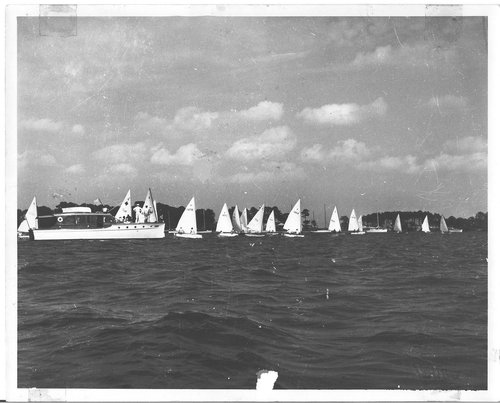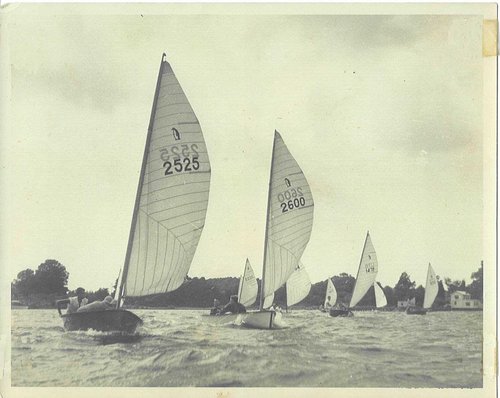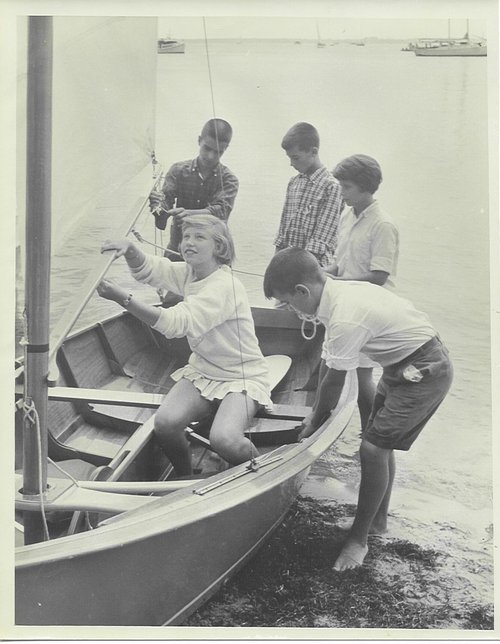by Jere Dennison
The Penguin is an 11-? foot cat-rigged dinghy intended to be raced by a crew of two. It was designed in 1933 by Philip Rhodes but the class did not grow beyond its prototype until seven years later when a group of northern Chesapeake yachtsmen first recognized its potential for introducing fleet racing at low cost to a broad range of people. Richard Henderson in his book, Chesapeake Sails: A History of Yachting on the Bay , states: It proved ideal for the developing method of simple construction utilizing sheet plywood. After plans were published in Yachting in 1940, the boat attracted nationwide interest and a national class was formed headed by William Heintz, a prominent Chesapeake yachtsman and chart publisher. A few months before Americas entry into World War II, the first national Penguin regatta was held in Annapolis.
As a young member way back in the 1950s, I would frequently hear the story of the great Penguin factory where many industrious Urbanna Yacht Club members came together to mass produce an entire one-design fleet with their own hands. Fortunately we do not have to depend on my fading memory for the details since there exists a contemporary published account of this saga. For several years, Isabel Dunn, then wife of club founder Reid Dunn, wrote a column for the Richmond Times-Dispatch entitled Light Airs that dealt primarily with activities at UYC and later FBYC. What follows is her column from June 22, 1947 in which she describes the creation of 15 garage-built Penguins.
Believe it or not- slick plywood dinghy hulls are rolling off a Richmond assembly line these days, and by mid-July, 15 of the popular 11 ? foot Penguins-all of them home grown-will crowd the list of locally owned sailing craft.
True, the assembly line is located in a West End garage, and the boat builders are local business and professional men, many of whom before last Fall, had never in their lives handled a tool more complicated than a household hammer, but, blow me down, and knock me overboard if they havent got honest-to-gee custom build hulls coming off the stocks here at the rate of two a week.
It all came about this way-last September 15 Richmond yachtsmen, all of them members of the Urbanna Yacht Club, got together to form a UYC Penguin fleet for the 1947 season, and, faced with sky-high prices for inferior stock hulls, decided to roll their own on a mass production basis. Forthwith, they organized themselves into what they labeled The Penguin Project, ordered a load of plywood, and set out to prove that two hands are better than one. 
They worked it like this-first step was taken by Robert Lyne, Richmond lawyer, who laid down and faired the hull lines, a job for which he was eminently suited since he helped lay down the lines of the battleship Pennsylvania. Following his move, Alan McCulloch, local architect, developed full-sized drawings of each individual work part, from which working patterns were made. Then Patrick A. Gibson, John Marshall Moseley, and Reid A. Dunn who headed up the project, made jigs for each boat frame and assembled a pilot model on which correctness of both patterns and jigs were verified. They planned for all the frames to be made at one time, to fit the jigs, after which they would be assembled to the keel over one master from, making 15 identical skeletons. This would allow the planking to be precut, at one time, for all the sides and bottoms.
After this stage, mass production began in earnest and the 15 holded in for a tough Winter of carpentry. The work was broken down into simple, individual jobs, each one requiring only one or two tools, a kitchen table, elbow grease, and a stout heart. For instance, while one member sawed gussets for the joints of the frames, another made the vertical parts of the frames for the topsides, and a third assembled these parts into frames.
Neighbors shook their heads as project members turned overnight from butcher, baker, and candle-stick maker into carpenters, pure and simple. A professor of romance languages at the University of Richmond made centerboard trunks in his living room; a lawyer turned out one transom after another from his basement; a doctor, several young executives, and a marine artist formed teams for assembling frames, and one member of the distaff side-Miss Mary Anne Pinder-sweated out the job of sandpapering hundreds of parts. Included were McDonald Wellford, Day Lowry, J. Rucker Ryland, Thomas Lavender, Gordon Harrison, Neil Chewning, Dr. Marvin Burton, James H. Scott, and William Chewning.

Several months ago, the boat builders secured a garage as an assembly point, and here the hulls are now being put together. Because the season is upon them, and they must speed up the job, the amateurs have recently relinquished their Corinthian standing, and employed Robert Evans, who is both a professional carpenter, and sailing enthusiast, to help them get the hulls off the stocks.
The boats are not the usual amateur jobs for several reasons. The frames and keels are of Sitka spruce, the lightest wood on the market for its strength, and unusual in kits used for home made boats. The hulls are planked with unique one-piece bottoms, for greater strength and a smoother surface, and a new plastic phenolic waterproof glue was used wherever two wood surfaces came together. Noncorrosive aluminum alloy fastenings were used throughout. The whole result is an extremely light hull, which should be sensitive, and easily handled, both in and out of the water.
So, despite smashed thumbs, charley horses, and a few new cuss words added to their vocabularies, Richmonds amateur boat builders have accomplished a feat worth noticing-they are now the proud owners of a fleet of custom built hulls-all identical, and all superior to stock boats, as well as having cost them a great deal less.
Luck to them on the race course!
During ensuing years, the Penguin fleet prospered and formed the nucleus of the one-design competition at UYC and later at FBYC. The picture included above shows a Penguin start during the early 1950s on Fishing Bay. Later, as most adults had moved on to the larger Hampton One-Design and eventually into Mobjacks and Jollyboats by the late 1950s, the Penguin continued to play an equally important role as the junior boat at FBYC until its demise as an active one-design fleet in the next decade. Here juniors pose with a Penguin in 1958 on our beach in front of the clubhouse.